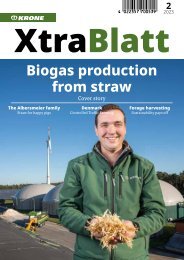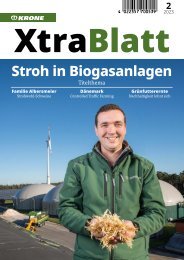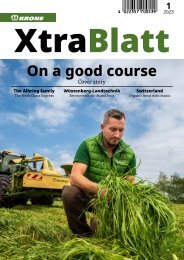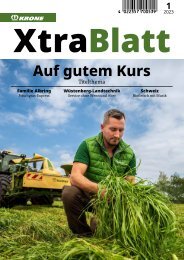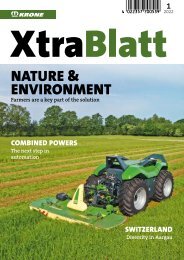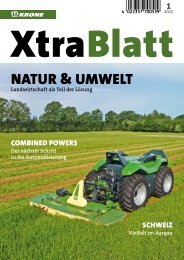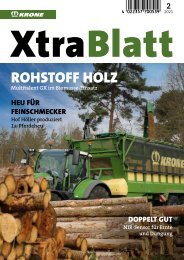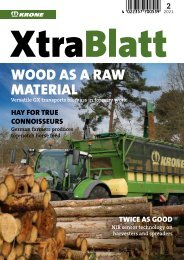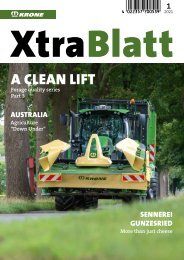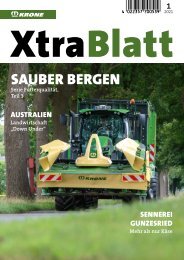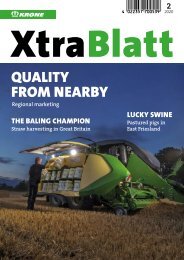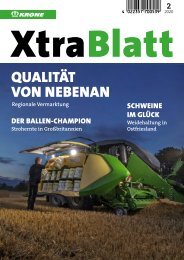XtraBlatt Issue 02-2017
Create successful ePaper yourself
Turn your PDF publications into a flip-book with our unique Google optimized e-Paper software.
1 Dr Klaus Martensen is Krone development manager<br />
for round and large square balers as well as forage<br />
wagons.<br />
2 For the first fixed chamber round baler, the floor<br />
scraper chain from the Optimat manure spreader<br />
got a new role as spike chain in the baler, forming<br />
bales within an enclosed sheet steel housing.<br />
3 4<br />
3 A prototype from 2000: the self-propelled Combi-<br />
Pack 1500.<br />
4 Between 1977 and now, Krone has built almost<br />
100,000 round balers.<br />
Dr Martensen: The Ultima is based on the semi-variable<br />
bale chamber with preceding bunker. And this first nonstop<br />
baler-wrapper combination on the market won the<br />
next Krone Agritechnica gold medal. The difference to the<br />
prototype is the cutter rotor. This originated in the forage<br />
wagon. During the net wrapping procedure, the rotor packs<br />
the preceding bunker full. The pre-packed material is then<br />
pressed into the newly emptied bale chamber in a single action<br />
which avoids loss of density. We achieve the same bale<br />
density as a comparable solo machine, the procedure is<br />
continuous and the Ultima so achieves 50% more throughput.<br />
With that, we were trend setter at that time.<br />
<strong>XtraBlatt</strong>: The Fortima was also presented at the 2011 Agritechnica<br />
as Vario Pack replacement. Although it wasn’t<br />
completely new …<br />
<strong>XtraBlatt</strong>: Latest development with round balers is wrapping<br />
in plastic sheeting. What are the advantages?<br />
Dr Martensen: Krone has had the Comprima with sheet<br />
wrapping on the market for two years now. An advantage<br />
is that the sheeting lies snug around the bale, keeping bale<br />
shape and achieving a very good coverage. Additionally,<br />
the procedure allows faster unwrapping, with the only<br />
waste the plastic sheet. With frost, for instance, it can be<br />
difficult to separate netting from bale surfaces. A negative<br />
factor is the high price of sheeting. Despite this, I see the<br />
share of plastic sheet wrapping with round baling already<br />
at almost 20%, with a strongly increasing tendency. Incidentally,<br />
we are the only manufacturer that runs the sheeting<br />
though at full width, exactly as with netting, and this<br />
reduces sheeting loss.<br />
Dr Martensen: Yes. The Fortima variable round baler was<br />
based on proven technology through face-lifting the Vario<br />
Pack. The design was modernised and the model equipped<br />
with the latest electronics. As with the Comprima, the pickup<br />
is camless. Two years later there came the Round Pack<br />
as Fortima. During the 2012 harvest in eastern Germany,<br />
a world record was established with a Comprima F 125 XC<br />
achieving a baling performance of 149/hour in a field featuring<br />
long continuous swathes of wheat straw.<br />
By 2013, the aim of offering professional customers still more<br />
performance led to the Comprima X-treme. The innovation<br />
here featured more robustness and, in the combination,<br />
more throughput performance through faster bale transfer<br />
and wrapping procedures. Nor should we, however, forget<br />
the Bellima, also introduced in 2011.This is a further development<br />
of the KR, the first generation of Krone round balers.<br />
<strong>XtraBlatt</strong>: What trends are developing now? How is it<br />
possible to get more performance from balers?<br />
Dr Martensen: The TIM system, i.e. Tractor Implement Management,<br />
whereby the implement quasi steers the tractor,<br />
continues to offer a lot of potential for relieving the operator<br />
and increasing performance. It’s also possible to get<br />
more throughput from modern headland management<br />
solutions. Throughput performance involves driving speed,<br />
i.e. performance of pickup and chopper, and knife sharpening<br />
once daily or hydraulic blade group control with<br />
26-knife cutter. However, in the same way, more material<br />
has to be compressed according to HDP. The question is:<br />
does the HDP system pay with round balers? It’s my opinion<br />
that the trend moves towards compact, robust machines<br />
with reduced servicing requirement and reliable performance<br />
through the short harvest period.”<br />
9



